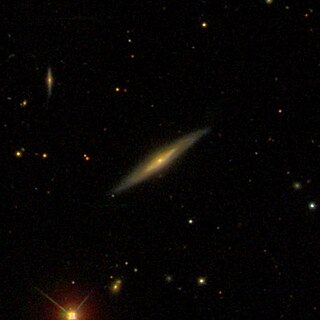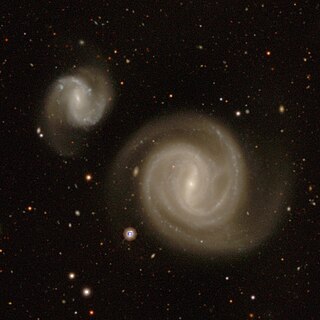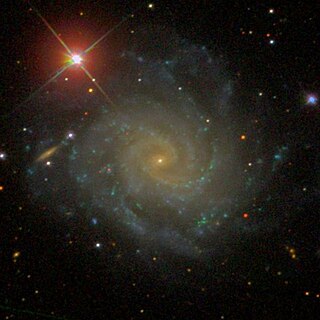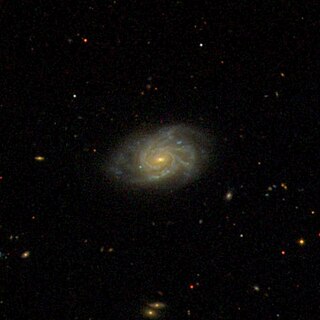
NGC 167 is a spiral galaxy located approximately 172 million light-years from the Solar System in the constellation Cetus. It was discovered in 1886 by Francis Preserved Leavenworth.

NGC 806 is a spiral galaxy approximately 166 million light-years away from Earth in the constellation Cetus. It was discovered by American astronomer Lewis A. Swift on November 1, 1886 with the 16" refractor at Warner Observatory.

NGC 519, also occasionally referred to as PGC 5182, is an elliptical galaxy located approximately 242 million light-years from the Solar System in the constellation Cetus. It was discovered on 20 November 1886 by astronomer Lewis Swift.

NGC 521, also occasionally referred to as PGC 5190 or UGC 962, is a barred spiral galaxy located approximately 224 million light-years from the Solar System in the constellation Cetus. It was discovered on 8 October 1785 by astronomer William Herschel.

NGC 522, also occasionally referred to as PGC 5218 or UGC 970, is a spiral galaxy located approximately 122 million light-years from the Solar System in the constellation Pisces. It was discovered on 25 September 1862 by astronomer Heinrich Louis d'Arrest.

NGC 3110, known as NGC 3122 and NGC 3518 is an active spiral galaxy in the Constellation Sextans. It contains extensive Hubble-type Sb star-forming regions, and is located south of the celestial equator. It is estimated to be 218 million light-years from the Milky Way and has a diameter of around 100,000 ly. Together with PGC 29184 it forms a gravitationally bound galaxy pair. Located in the same area of the sky is the galaxy IC 589.

NGC 561 is a barred spiral galaxy located in the constellation Andromeda. Its speed relative to the cosmic microwave background is 4,395 ± 20 km/s, which corresponds to a Hubble distance of 64.8 ± 4.6 Mpc. NGC 561 was discovered by Prussian astronomer Heinrich d'Arrest in 1862.

NGC 5850 is a barred spiral galaxy in the constellation Virgo. Its speed relative to the cosmic microwave background is 2,735 ± 13 km/s, which corresponds to a Hubble distance of 40.3 ± 2.8 Mpc. NGC 5850 was discovered by German-British astronomer William Herschel in 1786.

NGC 1009 is a large spiral galaxy in the constellation Cetus. Its speed relative to the cosmic microwave background is 5,594 ± 24 km/s, which corresponds to a Hubble distance of 82.5 ± 5.8 Mpc. NGC 1009 was discovered by American astronomer Edward Swift in 1886. The luminosity class of NGC 1009 is II and it has a broad HI line. To date, five non-redshift measurements yield a distance of 91.940 ± 3.045 Mpc, which is just outside the distance values of Hubble.

NGC 945 is a barred spiral galaxy in the constellation Cetus. It is located south of the celestial equator. It is estimated to be 200 million light-years from the Milky Way and about 135,000 light-years in diameter. Together with NGC 948, it forms a gravitationally bound pair of galaxies. In the same area of the sky there are, among other things: the galaxies NGC 942, NGC 943, NGC 950, IC 230. The Type Ib supernova SN 1998dt was observed here. The object was discovered by astronomer William Herschel on November 28, 1785. It is within close proximity to NGC 948.

NGC 2008 is a distant spiral galaxy located in the constellation Pictor. Its speed relative to the cosmic microwave background is 10,367 ± 11 km/s, which corresponds to a Hubble distance of 153 ± 11 Mpc. NGC 2008 was discovered by British astronomer John Herschel in 1834. The luminosity class of NGC 2008 is III with an apparent magnitude of 13.2.

NGC 4712 is a spiral galaxy located in the constellation Coma Berenices. Its speed relative to the cosmic microwave background is 4,664 ± 20 km/s, which corresponds to a Hubble distance of 68.8 ± 4.8 Mpc. NGC 4712 was discovered by German-British astronomer John Herschel in 1832.

NGC 5885 is an intermediate barred spiral galaxy located in the constellation Libra. Its speed relative to the cosmic microwave background is 2,185 ± 13 km/s, which corresponds to a Hubble distance of 32.3 ± 2.3 Mpc. NGC 5885 was discovered by German-British astronomer William Herschel in 1784.

NGC 1175, also known as the Peanut Galaxy, is a large lenticular galaxy located in the constellation Perseus. Its speed relative to the cosmic microwave background is 5,349 ± 19 km/s, which corresponds to a Hubble distance of 78.9 ± 5.5 Mpc. It was discovered by the German-British astronomer William Herschel in 1786.

NGC 5416 is a spiral galaxy and radio galaxy located in the constellation Boötes. Its speed relative to the cosmic microwave background is 6,499 ± 18 km/s, which corresponds to a Hubble distance of 95.9 ± 6.7 Mpc. NGC 5416 was discovered by German-British astronomer William Herschel in 1784.

NGC 3447 is a barred Magellanic spiral galaxy located in the constellation Leo. Its speed relative to the cosmic microwave background is 1,405 ± 34 km/s, which corresponds to a Hubble distance of 20.7 ± 1.5 Mpc. It was discovered by the British astronomer John Herschel in 1836.

NGC 3187, also known as HGC 44D, is a large barred spiral galaxy located in the constellation Leo. Its velocity relative to the cosmic microwave background is 1,901 ± 22 km/s, which corresponds to a Hubble distance of 28.0 ± 2.0 Mpc. NGC 3187 was discovered by Irish physicist George Stoney in 1850.

NGC 3177 is a spiral galaxy located in the constellation Leo. Its speed relative to the cosmic microwave background is 1,627 ± 22 km/s, which corresponds to a Hubble distance of 24.0 ± 1.7 Mpc. NGC 3177 was discovered by the German-British astronomer William Herschel in 1784.

NGC 5377 is an intermediate barred spiral galaxy located in the constellation Canes Venatici. Its speed relative to the cosmic microwave background is 1,951 ± 11 km/s, which corresponds to a Hubble distance of 28.8 ± 2.0 Mpc. NGC 5377 was discovered by German-British astronomer William Herschel in 1787.

NGC 5394 is a barred spiral galaxy located in the constellation Canes Venatici. Its speed relative to the cosmic microwave background is 3,639 ± 14 km/s, which corresponds to a Hubble distance of 53.7 ± 3.8 Mpc. NGC 5394 was discovered by German-British astronomer William Herschel in 1787.




















